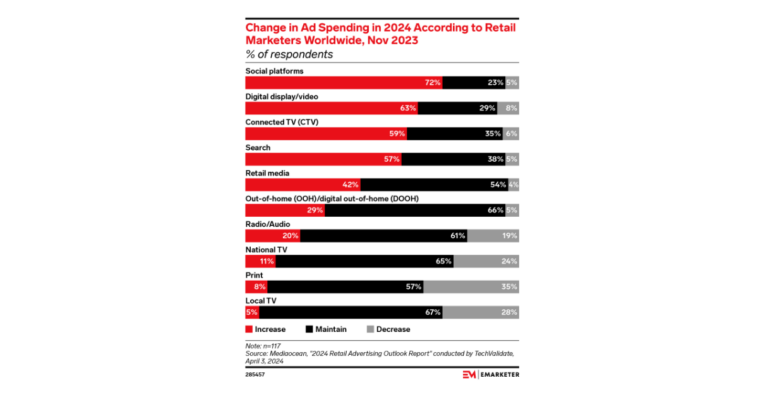A recent survey conducted by TechValidate and reported by Mediaocean in November 2023 has unveiled a compelling trend: nearly three-quarters (72%) of retail marketers worldwide are poised to increase their advertising spend on social platforms this year. This shift underscores the growing recognition of social media’s pivotal role in driving consumer engagement and boosting sales.
The retail industry, always at the forefront of adopting innovative marketing strategies, is expected to allocate a staggering $88.13 billion to digital advertising in 2024. This amount eclipses the spending of any other industry, highlighting the intense competition and the necessity for retailers to stay ahead in the digital advertising arena. A significant portion of this spending, approximately 29% or $25.51 billion, will be funneled into social media networks. This investment underscores the platforms’ effectiveness in reaching and influencing today’s digitally-savvy consumers.
Social media has evolved from being merely a platform for social interaction to a crucial touchpoint in the consumer purchase journey. According to a March 2024 survey by IZEA, two-thirds of U.S. social media users reported that they are at least somewhat likely to research a product via social media before making a purchase. This behavior highlights the importance of a strong social media presence for retailers. By leveraging these platforms, brands can provide detailed product information, user reviews, and personalized content that aids consumers in their decision-making process.
The strategic focus on social media advertising is driven by several factors. Firstly, the sheer reach of social media platforms is unparalleled. With billions of active users worldwide, platforms like Facebook, Instagram, TikTok, and Twitter offer retailers access to a vast and diverse audience. Additionally, the advanced targeting capabilities of these platforms enable marketers to deliver highly personalized and relevant ads to specific consumer segments. This precision targeting not only improves ad effectiveness but also maximizes return on investment.
Furthermore, social media platforms continually enhance their advertising features, providing retailers with innovative tools to create engaging and immersive ad experiences. From shoppable posts and stories to augmented reality (AR) ads and live shopping events, these features allow brands to connect with consumers in more interactive and meaningful ways. As a result, social media advertising is no longer just about brand awareness; it’s about driving direct sales and fostering long-term customer loyalty.
The shift towards increased social media ad spending also reflects broader changes in consumer behavior. Today’s consumers are increasingly turning to social media for product discovery, inspiration, and peer recommendations. Platforms like Instagram and Pinterest have become virtual showrooms where users can explore new products, see them in use through influencer partnerships, and read reviews from other customers. This social proof is incredibly powerful in influencing purchase decisions and building trust in a brand.
Moreover, the integration of social commerce features is transforming how consumers shop online. Social media platforms are seamlessly blending content and commerce, allowing users to purchase products directly within the app without being redirected to external websites. This streamlined shopping experience is not only convenient for consumers but also beneficial for retailers, as it reduces friction in the purchase process and increases conversion rates.






Comments
Loading…